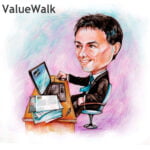//courtesy of BoogieJack.com
function killCopy(e){
return false
}
function reEnable(){
return true
}
document.onselectstart=new Function (“return false”)
if (window.sidebar){
document.onmousedown=killCopy
document.onclick=reEnable
}
Allan Mecham’s annual letter to Arlington Value Capital partners for the year ended December 31, 2015. According to a letter obtained by ValueWalk. See the full letter below.
Also see
[drizzle]Allan Mecham's Arlington Value2014 Annual Letter
AllAppearancean Mecham positions
Allan Mecham On The Bullish Case For Sony And Alleghany
The Next Warren Buffett? Allan Mecham – The Earlier Years
Will The Next Warren Buffett Please Stand Up?
Allan Mecham On His Investment Style; Favorite Books
Dear Partners,
2015 was a difficult year. I’m disappointed to report that AVM Ranger registered its first loss in 7+ years (Arlington Value Capital's first loss in over a decade). We finished the year down 6.7% vs. a gain of 1.4% for the S&P 500. This brings our 7.5-year annualized return to 30.9% vs. 8.7% for the S&P 500. (All figures are gross of fees as we have two different fee structures.)
(For long-term Arlington LPs, our 16-year annualized return is 20.1% vs. 4.1% for the S&P 500.)
Being down in any given 12-month period doesn’t necessarily demand disappointment, as price and value often diverge. More than sixty-five years ago, Ben Graham introduced his “Mr. Market” concept: a bipolar business partner who each day offers to buy your interests or sell you his—occasionally at irrational prices. This apt parable has passed the test of time, as history is littered with silly investment behavior. Ben Graham’s other adage has also retained merit: “In the short-run the market is a voting machine, in the long-run it’s a weighing machine.”
Unfortunately, part of our poor performance in 2015 can’t be attributed to a manic “Mr. Market” as it reflects mistakes I made. The poor results do not stem from a bevy of blunders; rather, my discipline slipped and execution suffered.
Though I’m disappointed with our results, bouts of volatility and underperformance at Arlington Value Capital are not without precedent. A look back over Arlington Value Capital's 16-year history reveals multiple periods of volatility and lagging performance. The table below provides historical context:
Twelve years ago I penned my annual letter and referenced a study that highlighted 5 funds with 15-year records that handily beat the S&P 500 yet underperformed 30% of the time. Back then I speculated that if we were to continue to outperform we would need to accept periods of underperformance as well.
After 16+ years my opinion hasn’t changed. In fact, I think a dispassionate attitude toward potential quotational loss is a prerequisite to achieving solid long-term results. Our preferred antidote is to don a business owner’s hat (who buys for keeps), instead of a fund manager’s hat who’s unduly concerned with short-term measures. This common-sense attitude helps calibrate our analysis to think about long-term earnings power and intrinsic value; although, it doesn’t guarantee mistake-free investing.
Arlington Value Capital - Portfolio Overview
2015 was a tale of two halves: the first half was marked by muted action (minor selling) and a cash position, while the second half saw excessive activity and poor returns. Unlike the Vegas slot-player however, the stock market’s instant-feedback system doesn't always accurately reflect success or failure. In investing, mistakes occur when decisions are made yet sometimes don’t vest until much later. I’m a big believer in learning from mistakes (unfortunately, I keep furthering my education); however, I think it’s dangerous to let short-term wiggles drive frenetic postmortems. Conversely, I try to be alert to hairline cracks in my analysis, irrespective of stock price action.
Arlington Value Capital - Outerwall Inc. (OUTR)
The major black eye impacting 2015 (though the decision was made in late 2014) was our investment in OUTR. This was a mistake I should have avoided. My assumptions appear faulty, and I clearly underestimated the effects of substitutes on consumer behavior.
Further, I should have insisted upon first-class stewardship before considering an investment given the challenges at Redbox. With scarce reinvestment options and a declining business, capital allocation (important in any business) takes on critical importance. The conditions prevailing at OUTR demand thoughtful capital allocation, not a blind devotion to venture-like investments in kiosk businesses and systematic share buybacks without reference to value or opportunity costs.
In hindsight, I should have recognized the folly of investing alongside executives with poor incentives (no skin in the game), and a destructive record of capital allocation. I naively thought our overtures would nudge management and the board in the right direction and produce smart results … Lesson learned.
The critical variables at OUTR rest upon Redbox’s future decline rate (and associated level of cash flows) and the efficacy of future capital allocation. Given the many variables at play, it’s hard to know if Redbox’s recently reported decline rate will continue apace, accelerate, or perhaps snap back slightly (given better content buying and a stronger release slate) and moderate in the years ahead. Equally important is our unease with the current management and board of directors.
As of this writing there’s hopeful news: Glenn Welling at Engaged Capital (an “activist” hedge fund) has taken a large stake and is advocating urgent change. Engaged Capital’s top priorities are to redirect capital allocation and sell the company. In the near term we plan on working with interested parties to support rational behavior and value creation. Unfortunately, even under new leadership OUTR will likely remain a candidate for my “wall of shame,” serving as a reminder to avoid similar mistakes in the future. If we were to sell out of our remaining position today–around $34 per share–OUTR would end up costing us roughly 4.5% of capital, one of the worst losses in our 16-year history.
Arlington Value Capital - NOW Inc (DNOW) & MSC Direct (MSM)
Beyond OUTR, we had a few new positions suffer declines in 2015, though I don’t believe they’re mistakes. Midway through the year, feeling happy with a 10% gain andidle cash, I was attracted to two companies, DNOW & MSM, that harbored key elements I look for in businesses: staying power and unique competitive positions within their respective industries. Both companies are distributors with business models that generate cash in downturns and require minimal capital expenditures. Further, both DNOW and MSM enjoy scale advantages, strong balance sheets, and seasoned management teams with strong track records.
In both cases, what appeared moderately cheap (perhaps I could have exercised better price discipline) became cheaper as industry headwinds intensified. I was somewhat ambivalent to the declines (which reflected industry challenges), as part of the investment appeal rested upon my view that growing stress would benefit both companies at the expense of competitors.
MSC CEO Erik Gerstner explains in the most recent Q:
Economic slowdowns are the times when MSC makes its greatest strides. These are the times when the local and regional distributors that make up 70% of our market suffer disproportionately. History tells us what will happen to local distributors if this downturn prolongs. Reducing their inventory leaves customer service vulnerable. Clamping down on receivables disrupts long-standing customer relationships. Laying off people creates hiring opportunities to acquire industry talent not typically available.
We are just starting to see the very early signs of these things occur in the marketplace. The pace will accelerate the longer these conditions hold. We are pleased with our share gain performance to date and would anticipate it to continue or even accelerate the longer these conditions last, and that will lead to disproportionate top-line growth when the environment does improve.
Although there are important nuances among distribution companies (I’ll spare you the details), I believe both DNOW and MSM share significant competitive advantages. We’re confident the challenging conditions that now prevail will create opportunities for both firms to gain market share, improve underlying economics, and grow intrinsic value over time.
Arlington Value Capital - Leucadia National (LUK)
Leucadia is a diverse conglomerate we started accumulating in September of 2014. Similar to DNOW and MSM, LUK has a strong balance sheet, conservative culture, and leadership that’s experienced in taking advantage of opportunities in a distressed market.
We’ve long followed LUK and admired the business acumen of Joe Steinberg and Ian Cummings, the legendary duo that founded LUK in 1978 and went on to produce one of history’s great track records. Watching the investing prowess of this duo produced a lot of head-scratching and immense value creation for shareholders.
In early 2013, as a solution to succession planning, Ian Cummings and Joe Steinberg merged LUK with Jefferies and turned over the reigns to Rich Handler and Brian Friedman, two executives with an impressive track record running Jefferies. LUK’s long history with Jefferies, as a customer and investor, gave us added confidence that the cultures of the two firms would sync up.
Today LUK is run by Rich Handler and Brian Friedman, with Joe Steinberg serving as chairman of the board. LUK’s eclectic group of subsidiaries touch numerous industries, from beef processing to investment banking, and while a few of LUK’s subsidiaries are firing on all cylinders, most are struggling, earning sub-par returns on capital amid challenging conditions. We believe the difficulties afflicting many of LUK’s subsidiaries will prove temporary, and earnings power will rise in the future. In the meantime, LUK’s opportunistic culture, strong balance sheet, and savvy stewardship offer a good prospect of value creation via opportunistic investments: the hallmark of LUK’s success.
Arlington Value Capital - Cimpress (CMPR)
CMPR’s largest business, Vistaprint (accounting for 70% of CMPR’s sales), turned in a solid year with key metrics improving across the board: customer loyalty strengthened, average order values grew, and net promoter score increased. Robert Keane and team are large owners and long-term thinkers, focused on reinvesting capital to expand the moat and grow intrinsic value. We’re thrilled to be co-owners and support the heavy spending and long-term focus. It’s worth noting, even amid aggressive spending, the Vistaprint business sports healthy margins and attractive returns on capital.
In addition to large outlays at Vistaprint, management has ramped up investments in the Upload and Print space, acquiring a handful of companies of late. This market caters to higher-expectation customers and looks like an attractive fit for CMPR. During CMPR’s annual investor day in August, management laid out their long-term plan to create a Mass Customization Platform built upon CMPR’s network of businesses and third party affiliates. The goal is to leverage CMPR’s strengths (production, technology, and logistics) to create an unmatched value proposition serving the print marketing needs of small businesses worldwide.
CMPR is chock-full of business qualities we crave: dominant and durable businesses in niche markets, run by owner-oriented managers who are laser focused on growing intrinsic value per share. We’re confident that CMPR’s powerful competitive advantages, attractive underlying economics, and long runway ahead will produce growing earnings and shareholder value.
Additionally this year, we decided to sell a large chunk of SNE as the price rose significantly. While SNE’s management is executing well, they compete in fiercely competitive markets that make sustainable strong returns elusive. We sold as the price approached a more reasonable representation of value and the margin of safety shrunk. We also exited Allegany and BAC after nice gains to reallocate the proceeds elsewhere.
Arlington Value Capital - Conclusion
I’d like to reiterate our appreciation to all of Arlington LPs. The mistakes I made in 2015 were all self-imposed with zero outside pressure. After some reflection, I think a long run of solid returns and a cash position sedated my discipline slightly, nudging me toward excessive activity.
While some positions declined in 2015, the ultimate arbiter of our future performance will largely be driven by the underlying operating results of the businesses we own. We’re lucky to have LPs that share our long-term attitude, allowing our theses to play out. I have confidence that with the passage of time, the businesses we own will generate results that support satisfactory returns for Arlington Value Capital.
Our band of partners grew further in 2015 with total assets under management tallying roughly $750 million as of this writing. As we’ve grown, Ben and I have thought long about the appropriate level of assets under management. Each dollar we take in works against LPs interests–though to date we think the penalty has been very slight. To reciprocate your trust and support, we’ve decided to close the fund when assets reach between 1 and 1.2 billion: a level that we believe is small enough to preserve our ability to add value to LPs.
I’m never comfortable predicting short-term stock price movements and can’t guarantee that we will rebound in 2016. However, I can guarantee that Ben and I will continue to have 100% of our liquid assets (outside of real estate) invested alongside you with zero outside commitments to other funds or securities. This commitment speaks to our long-term confidence in Arlington Value Capital.
I look forward to reporting again next year.
Sincerely,
Allan Mecham













